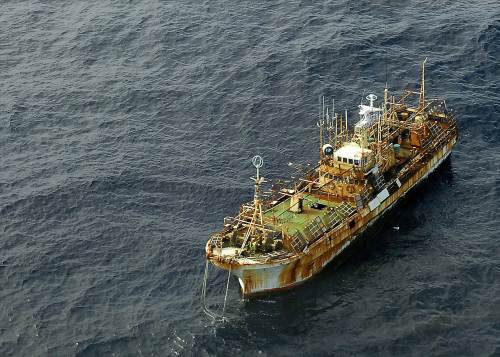The U.S. Coast Guard unleashed cannon fire Thursday at a Japanese vessel set adrift by last year's tsunami, stopping the ship's long, lonely voyage across the Pacific Ocean.
A Coast Guard cutter fired on the abandoned 164-foot (50-meter) Ryou-Un Maru in the waters of the Gulf of Alaska and more than 150 miles (240 kilometers) from land, spokesman Paul Webb said.
 |
In this image obtained from the US Coast Guard (USCG), the unmanned Japanese fishing vessel Ryou-un Maru drifts northwest approximatley 164 miles (264kms) southwest of Baranof Island, Alaska, on April 4, 2012. |
Soon after the cannon fire started, the ship burst into flames, began to take on water and list, Chief Petty Officer Kip Wadlow said.
About two hours later, the vessel hadn't sunk and the cutter resumed shelling, Lt. Veronica Colbath said.
The vessel poses a significant hazard and the Coast Guard has been warning mariners to stay away, Wadlow said. Aviation authorities are also advising pilots to steer clear of the area.
Officials decided to sink the ship rather than risk the chance of it running aground or endangering other vessels. The ship has no lights or communications system and has a tank that could carry more than 2,000 gallons (7,500 liters) of diesel fuel.
They don't know how much fuel, if any, is aboard. ``It's less risky than it would be running into shore or running into (maritime) traffic,'' Webb said.
The ship had been destined for scrapping when the Japan earthquake struck, so there is no cargo on board, according to Webb. He said he doesn't know who owns the Ryou-Un Maru, which has been traveling about 1 mile per hour (2.2 kph) in the past days.
Earlier, Webb said the cutter was going to fire the cannons from several hundred feet away. The goal is to punch holes in the Ryou-Un Maru and sink it. A Coast Guard C-130 plane crew was monitoring the operation.
A Canadian fishing vessel, the 62-foot (19-meter) Bernice C, claimed salvage rights over the ghost ship. The Coast Guard stopped their plans to fire so the Canadian crew could have a chance to take the stricken ship.
A Canadian official with knowledge of the situation told The Associated Press that the Bernice C was unable to tow the abandoned ship.
The National Oceanic and Atmospheric Administration and the Environmental Protection Agency studied the problem and decided it is safer to sink the ship and let the fuel evaporate in the open water.
The vessel has been adrift from Hokkaido, Japan, since it was launched by the tsunami caused by the magnitude-9.0 earthquake that struck Japan in March 2011. About 5 million tons of debris were swept into the ocean by the tsunami.
The Japan earthquake triggered the world's worst nuclear crisis since the Chernobyl accident in 1986, but Alaska state health and environmental officials have said there's little need to be worried that debris landing on Alaska shores will be contaminated by radiation.
They have been working with federal counterparts to gauge the danger of debris including material affected by a damaged nuclear power plant, to see if Alaska residents, seafood or wild game could be affected.
In January, a half dozen large buoys suspected to be from Japanese oyster farms appeared at the top of Alaska's panhandle and may be among the first debris from the tsunami. (AP)








